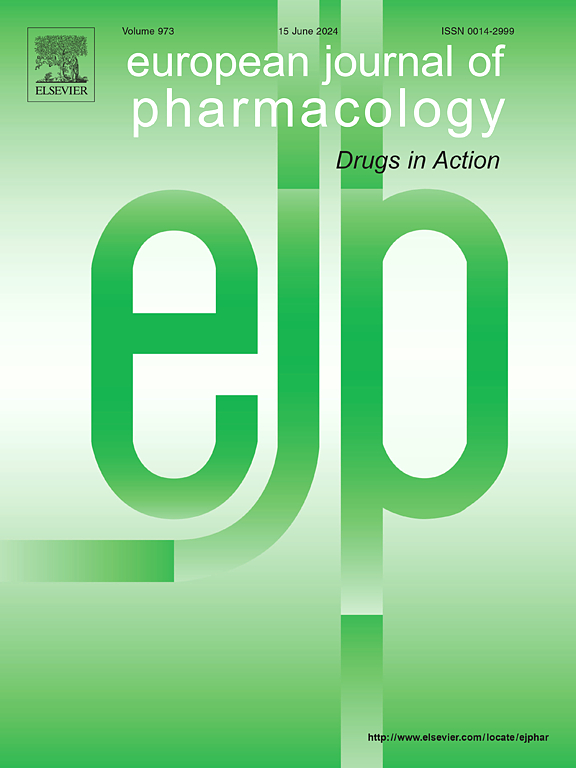TRPM4 channels contribute to Adriamycin chemoresistance in breast cancer cells
IF 4.2
3区 医学
Q1 PHARMACOLOGY & PHARMACY
引用次数: 0
Abstract
Chemoresistance presents a critical challenge in breast cancer treatment. Here, we report that transient receptor potential melastatin 4 (TRPM4) plays a role in modulating doxorubicin (ADR) resistance in breast cancer cells. TRPM4 expression was significantly upregulated at both the mRNA and protein levels in MCF-7/ADR cells, a human breast cancer cell line resistant to the chemotherapy drug ADR. Pharmacological inhibition or knockdown of TRPM4 restored ADR sensitivity, while its overexpression in non-resistant MCF-7 cells diminished drug response, confirming the regulatory role of TRPM4 in resistance mechanisms. Western blot analyses confirmed that elevated TRPM4 expression drives P-glycoprotein (P-gp) upregulation in both MCF-7/ADR and KBv200 cells (KB vinblastine 200 resistant cell line), as well as in Huh7 (human hepatocellular carcinoma cell line) and HCT116 (human colorectal cancer cell line). In addition, we demonstrate that TRPM4 inhibition suppresses the level of NF-κB, a pivotal transcription factor regulating P-gp expression. Furthermore, we found that TRPM4-mediated cellular swelling, rather than membrane depolarization, is the primary driver of P-gp overexpression. Drug-resistant MCF-7/ADR cells exhibited significantly larger cell sizes compared to non-resistant MCF-7 cells, and this effect was reversed following TRPM4 inhibition. The swelling was induced by hypotonic stress rather than changes in membrane potential, further confirming the role of TRPM4 in P-gp regulation through volume changes. Analysis of the TCGA (The Cancer Genome Atlas) database revealed that elevated TRPM4 expression correlates with reduced patient survival, suggesting that TRPM4 plays a role in both drug resistance and tumor progression. Our findings provide new insights into the role of TRPM4 in resistance mechanisms and propose that targeting TRPM4 could represent an innovative therapeutic strategy to overcome chemoresistance and enhance drug efficacy in breast cancer.
TRPM4通道参与乳腺癌细胞阿霉素化疗耐药
化疗耐药性是乳腺癌治疗过程中面临的一项严峻挑战。在这里,我们报告了瞬时受体电位美司他丁 4(TRPM4)在调节乳腺癌细胞的多柔比星(ADR)耐药性中的作用。TRPM4在MCF-7/ADR细胞(一种对化疗药物ADR具有耐药性的人类乳腺癌细胞系)中的mRNA和蛋白质水平上的表达均明显上调。药理抑制或敲除TRPM4可恢复对ADR的敏感性,而在非耐药性MCF-7细胞中过表达TRPM4则会降低药物反应,这证实了TRPM4在耐药性机制中的调控作用。Western印迹分析证实,TRPM4表达的升高推动了P-糖蛋白(P-gp)在MCF-7/ADR和KBv200细胞(KB长春新碱200耐药细胞系)以及Huh7(人肝癌细胞系)和HCT116(人结直肠癌细胞系)中的上调。此外,我们还证明抑制 TRPM4 可抑制 NF-κB 的水平,NF-κB 是调控 P-gp 表达的关键转录因子。此外,我们还发现,TRPM4 介导的细胞肿胀而非膜去极化是 P-gp 过表达的主要驱动因素。与非耐药 MCF-7 细胞相比,耐药 MCF-7/ADR 细胞的细胞体积明显增大,而抑制 TRPM4 后,这种效应被逆转。肿胀是由低渗压力而不是膜电位变化引起的,这进一步证实了TRPM4通过体积变化在P-gp调控中的作用。对TCGA(癌症基因组图谱)数据库的分析表明,TRPM4表达的升高与患者生存率的降低有关,这表明TRPM4在耐药性和肿瘤进展中都起着作用。我们的研究结果为TRPM4在耐药机制中的作用提供了新的见解,并提出靶向TRPM4可能是克服乳腺癌化疗耐药性和提高药物疗效的一种创新治疗策略。
本文章由计算机程序翻译,如有差异,请以英文原文为准。
求助全文
约1分钟内获得全文
求助全文
来源期刊
CiteScore
9.00
自引率
0.00%
发文量
572
审稿时长
34 days
期刊介绍:
The European Journal of Pharmacology publishes research papers covering all aspects of experimental pharmacology with focus on the mechanism of action of structurally identified compounds affecting biological systems.
The scope includes:
Behavioural pharmacology
Neuropharmacology and analgesia
Cardiovascular pharmacology
Pulmonary, gastrointestinal and urogenital pharmacology
Endocrine pharmacology
Immunopharmacology and inflammation
Molecular and cellular pharmacology
Regenerative pharmacology
Biologicals and biotherapeutics
Translational pharmacology
Nutriceutical pharmacology.

 求助内容:
求助内容: 应助结果提醒方式:
应助结果提醒方式:


